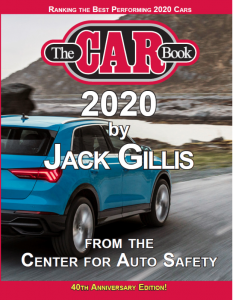The following year NHTSA crash tested the 1981 Honda Civic. Honda had made several safety modifications beginning with the 1981 Civic model that resulted in passing the crash tests in what was the new NCAP Program.
Three years ago, Legal Reader’s Editor, Jay W. Belle Isle, informed readers of the life, limb, and livelihood saving potential of using information in the 2017 Car Book to protect themselves. 1
Since 2017, we have seen gross mal-governance increase the need for citizens to protect ourselves using safety information. Now updated, the 2020 Car Book is available in digital format. And, for the last time after 40 years, this is the last issue in hardcopy format.
The 2020 Car Book is an excellent reference. It contains valuable information on buying, maintaining, fueling, and insuring the vehicle you choose. 2
You can choose wisely a vehicle most likely to save you time, money, aggravation, and your life and the lives of your loved ones. In these years of captured regulatory agencies, you can avoid being a NHTSA Dummy. 3
The 2020 Car Book can help us all protect ourselves.

Evidence That Car Book Information Has Saved Many Lives
In the first Car Book published by NHTSA in 1980, under the leadership of Administrator Joan Claybrook, the public learned that the Honda Civic failed the test for both driver and front passenger crash test dummies. 4
The publicity of the failure spurred Honda to make safety improvements.
Evidence of the safety importance of publicizing New Car Assessment Program (NCAP) tests was documented in a 1993 NHTSA Report to Congress. 5
Before the first Car Book, Honda had launched the 1980 Civic. In one of NHTSA’s first tests, the 1980 model Honda Civic failed and the results published in the first Car Book. The following year NHTSA crash tested the 1981 Honda Civic. Honda had made several safety modifications beginning with the 1981 Civic model that resulted in passing the crash tests in what was the new NCAP Program.
A decade later, I was managing a NHTSA program at the University of Miami studying crashes, injuries, treatments, and outcomes. We had a serious crash involving a 1981 Civic where the driver surprisingly survived. Knowing of the improvements made by Honda to the 1981 Honda Civic, we decided to investigate whether this was an anecdotal success. Or, was there statistical evidence of life saving in the real world experience of vehicles with the safety improvements.
The 1993 NHTSA Report to Congress on NCAP has the safety story on the 1981 Honda Civic. See pp. 79 – 82. The Report describes physical changes in the 1981 Civic that had been made after the 1980 Civic had failed the first NCAP crash test.
The laboratory crash test data of the 1981 Honda Civic safety improvements to reduce forces to the head and chest is shown in Table 5.
Table 6 shows difference in the real world results of the improvements in 1981 Civics compared with 1980 Civics. The results found a real world statistical success. The fatality rates in 1981 Civics were reduced by 42% based on five years of 1982-1988 Fatal Accident Reporting System (FARS) data.
This is a specific example of the importance of publishing crash test data to stimulate safety features that result in significant reductions in fatalities.
Unfortunately, the NHTSA Report to Congress did not include (because we did not have documents) that the costs to Honda for these mechanical improvements amounted to about $13.60 per vehicle.
I only knew this as the Honda Chief Engineer who had been in charge of the modifications had come to my office and I showed him the statistical analysis. When he expressed pleasure with the results, I asked him how much each change cost. From memory, he related each item and I noted them to amount to $13.60 per car in 1980 dollars.
Adjusted to 2020 dollars, the safety improvements would cost $42.69 per car.
Note in addition to substantial benefits in fatality reductions, there also are serious injury reduction benefits that NHTSA did not have statistical databases to enable quantification. As a general rule of thumb, the number of serious injuries amounts to about four times the number of fatalities.
References:


Join the conversation!